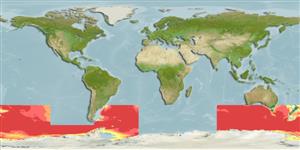>
Gadiformes (Cods) >
Macrouridae (Grenadiers or rattails)
Etymology: Cynomacrurus: Greek, kyon = dog + Greek, odous = teeth + Greek, makros = great + Greek, oura = tail (Ref. 45335).
Environment: milieu / climate zone / depth range / distribution range
Ökologie
seewasser bathypelagisch; tiefenbereich 500 - 3800 m (Ref. 1371), usually 1000 - 2000 m (Ref. 1371). Deep-water; 36°S - 79°S, 80°E - 14°W (Ref. 1371)
Southern Ocean: circumpolar, extending north of Convergence in some areas.
Size / Gewicht / Alter
Maturity: Lm ? range ? - ? cm
Max length : 50.0 cm TL Männchen/unbestimmt; (Ref. 1371)
Kurzbeschreibung
Morphologie | Morphometrie
Rückenflossenstacheln (insgesamt): 0; Afterflossenstacheln 0. Head profile rounded; snout short, blunt. Scales deciduous, with 1 to 3 divergent rows of small, thin spinules uniformly covering almost all of the body; scales absent over most of the snout and in wide patches on the head surrounding large pores of sensory lateralis system. Pyloric caeca rather long and slender, about 9 to 10. Overall color is dark brown to brownish black.
Feeds on fish, copepods and other small invertebrates (Ref. 5097).
Life cycle and mating behavior
Geschlechtsreife | Fortpflanzung | Ablaichen | Eier | Fecundity | Larven
Cohen, D.M., T. Inada, T. Iwamoto and N. Scialabba, 1990. FAO species catalogue. Vol. 10. Gadiform fishes of the world (Order Gadiformes). An annotated and illustrated catalogue of cods, hakes, grenadiers and other gadiform fishes known to date. FAO Fish. Synop. 125(10). Rome: FAO. 442 p. (Ref. 1371)
IUCN Rote Liste Status (Ref. 130435)
Bedrohung für Menschen
Harmless
Nutzung durch Menschen
Fischereien: nicht kommerziell
Mehr Information
NamenSynonymeMetabolismusRäuberÖkotoxikologieFortpflanzungGeschlechtsreifeAblaichenSpawning aggregationFecundityEierEientwicklung
Alter/GrößeWachstumLänge-GewichtLänge-LängeLängenhäufigkeitenMorphometrieMorphologieLarvenLarven Pop.Dyn.RekrutierungDichteBRUVS
ReferenzenAquakulturAquakultur ProfilZuchtlinienGenetikElectrophoresesVererbbarkeitKrankheitenVerarbeitungNutrientsMass conversion
Tools
Zusatzinformationen
Download XML
Internet Quellen
Estimates based on models
Preferred temperature (Ref.
123201): -0.1 - 2.9, mean 0.7 °C (based on 1002 cells).
Phylogenetic diversity index (Ref.
82804): PD
50 = 1.0000 [Uniqueness, from 0.5 = low to 2.0 = high].
Bayesian length-weight: a=0.00219 (0.00111 - 0.00431), b=3.20 (3.03 - 3.37), in cm total length, based on LWR estimates for this (Sub)family-body shape (Ref.
93245).
Trophic level (Ref.
69278): 3.4 ±0.40 se; based on food items.
Widerstandsfähigkeit (Ref.
120179): sehr niedrig, Verdopplung der Population dauert mehr als 14 Jahre. (Preliminary K or Fecundity.).
Fishing Vulnerability (Ref.
59153): Moderate vulnerability (40 of 100).
Climate Vulnerability (Ref.
125649): High to very high vulnerability (66 of 100).
Nutrients (Ref.
124155): Calcium = 27.5 [8.7, 63.6] mg/100g; Iron = 0.343 [0.151, 0.967] mg/100g; Protein = 17.1 [15.2, 18.8] %; Omega3 = 0.123 [0.047, 0.306] g/100g; Selenium = 23.5 [7.5, 64.5] μg/100g; VitaminA = 32.1 [4.1, 267.0] μg/100g; Zinc = 0.518 [0.280, 1.039] mg/100g (wet weight);
